Primula fassettii A.R. Mast & Reveal
Jeweled Shooting Star

Native
CC = 10
CW = 5
MOC = 5
SRank = S2
© SRTurner
Primula fassettii A.R. Mast & RevealJeweled Shooting Star | |
 |
Native CC = 10 CW = 5 MOC = 5 SRank = S2 |
© SRTurner |
|
Family - Primulaceae Habit - Rhizomatous perennial forb. Stems - Absent. Leaves - All basal, in a dense rosette. Blades 10-25 cm long, the blades narrowly to broadly oblanceolate or elliptic-oblanceolate, gradually tapered at the base, lacking a distinct petiole, rounded or broadly angled to a blunt point at the tip, the margins entire to inconspicuously scalloped, the surfaces glabrous, lacking reddish coloration at the base, especially along the midvein.
Inflorescence - Umbels. Scapes 15-25 cm tall, glabrous. Umbels with 2-7 flowers, the involucral bracts 3-6 mm long, lanceolate, the flower stalks 3-5 cm long, glabrous.
Flowers - Calyces 6-9 mm long, deeply lobed. Corollas with the tube 2-3 mm long, purple to maroon at the throat, the lobes 10-12 mm long, 3-4 mm wide, strongly reflexed, pink or lavender to rose-purple, rarely white, usually yellow at the base. Stamens exserted, the filaments fused into a membranous tube or nearly free, the anthers 6-7 mm long, fused into a tube around the style, the bases of their connectives expanded and purple. Style 7-9 mm long, slender, the stigma minute, capitate.
Fruits - Capsules 9-11 mm long, 3-4 mm wide, relatively thin and papery-walled, light brown to yellowish brown. Seeds 0.7-1.0 mm long, more or less cuboid, angular, brown. Flowering - May - June. Habitat - Moist ledges and tops of limestone and dolomite bluffs. Origin - Native to the U.S. Lookalikes - Primula meadia, P. frenchii. Other info. - This species is uncommon across its range, which includes only a few counties in central Missouri up through parts of the upper Midwest, with disjunct populations in northern West Virigina and southern Pennsylvania. It is quite habitat-specific, being found on calcareous rock bluffs, sometimes growing directly in small soil-bearing pockets of the rock face, as in the photos above. Photographs taken at Ha Ha Tonka State Park, Camden County, MO, 4-22-2023 (SRTurner). |